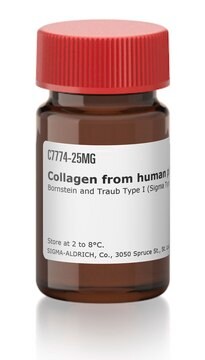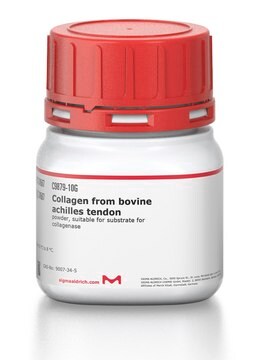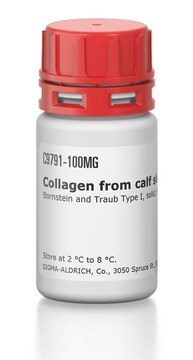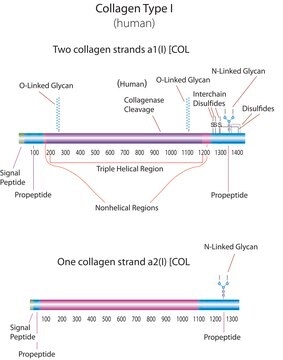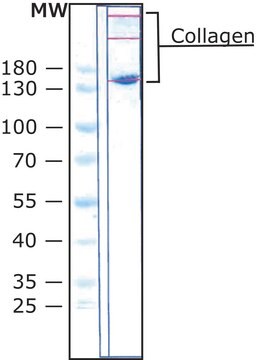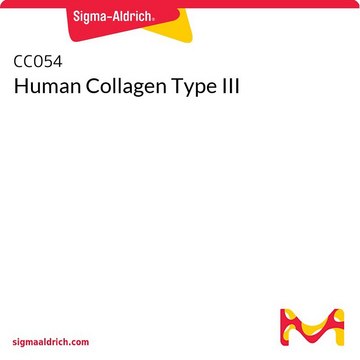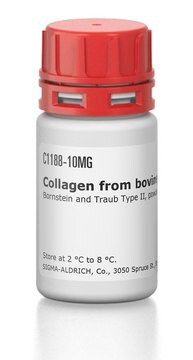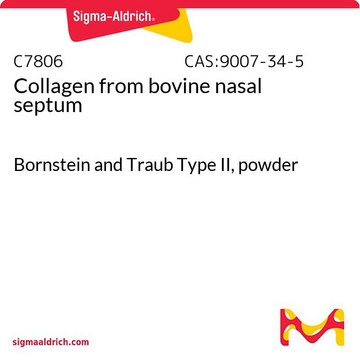C4407
Human Collagen Type III
from human placenta, powder, suitable for cell culture
Autenticatiper visualizzare i prezzi riservati alla tua organizzazione & contrattuali
About This Item
Prodotti consigliati
Nome del prodotto
Collagene, Bornstein and Traub Type III (Sigma Type X), powder
Origine biologica
human placenta
Livello qualitativo
Saggio
≥90% (GE)
Stato
powder
tecniche
cell culture | mammalian: suitable
Impurezze
HIV, hepatitis B and hepatitis C, none detected
Solubilità
aqueous acid: soluble
N° accesso UniProt
Temperatura di conservazione
2-8°C
Informazioni sul gene
human ... COL3A1(1300)
Cerchi prodotti simili? Visita Guida al confronto tra prodotti
Applicazioni
Collagen from human placenta has been used to assess the bioelectric effects of quinine on airway epithelial cells, to study the selective toxicity of engineered lentvirus lytic peptides and in a particle aggregation assay for the rapid detection of fibronectin, fibrinogen and collagen receptors on Staphylococcus aureus. It has also been used in a magnesium-dependent, collagen-binding assay during characterization of human lung tumor-associated antigens.
Componenti
All collagen molecules are composed of three polypeptide chains arranged in a triple helical conformation, with a primary structure that is mostly a repeating motif with glycine in every third position and proline or 4-hydroxyproline frequently preceding the glycine residue.
Avvertenza
This product should be stored at 2-8 °C and will retain activity in these conditions for 2 years.
Nota sulla preparazione
This product was prepared by a modification of the pepsin extraction and salt fractionation method of Hill, R.J. and Harper, E., Anal. Biochem., 141 (1984). It is a lyophilized powder that can be reconstituted in sterile .5 M acetic acid, PBS or water at 1 mg/mL. A PBS solution will be stable for at least one year at -20°C.
Risultati analitici
An SDS polyacrylamide gel electrophoresis test run under reducing conditions consistent with basement membrane collagen yields three major bands.
Altre note
Il collagene è classificato in diversi tipi strutturalmente e geneticamente distinti. Sigma utilizza la nomenclatura proposta da Bornstein e Traub. Occorre prestare attenzione a non confondere le denominazioni delle tipologie Sigma con le classificazioni del collagene universalmente riconosciute.
Codice della classe di stoccaggio
11 - Combustible Solids
Classe di pericolosità dell'acqua (WGK)
WGK 1
Punto d’infiammabilità (°F)
Not applicable
Punto d’infiammabilità (°C)
Not applicable
Dispositivi di protezione individuale
Eyeshields, Gloves, type N95 (US)
Scegli una delle versioni più recenti:
Possiedi già questo prodotto?
I documenti relativi ai prodotti acquistati recentemente sono disponibili nell’Archivio dei documenti.
I clienti hanno visto anche
Sanne L N Brouns et al.
Research and practice in thrombosis and haemostasis, 6(2), e12678-e12678 (2022-03-15)
Low plasma levels of protein C or protein S are associated with venous thromboembolism rather than myocardial infarction. The high coagulant activity in patients with thrombophilia with a (familial) defect in protein C or S is explained by defective protein
Johana Hrdinova et al.
International journal of molecular sciences, 23(4) (2022-02-27)
The plasmatic von Willebrand factor (VWF) circulates in a compact form unable to bind platelets. Upon shear stress, the VWF A1 domain is exposed, allowing VWF-binding to platelet glycoprotein Ib-V-IX (GPIbα chain). For a better understanding of the role of
Natalie J Jooss et al.
International journal of molecular sciences, 20(11) (2019-06-12)
Platelet interaction with collagens, via von Willebrand factor, is a potent trigger of shear-dependent thrombus formation mediated by subsequent engagement of the signaling collagen receptor glycoprotein (GP)VI, enforced by integrin α2β1. Protein tyrosine kinase Syk is central in the GPVI-induced
Sanne L N Brouns et al.
Scientific reports, 10(1), 11910-11910 (2020-07-19)
In haemostasis and thrombosis, platelet, coagulation and anticoagulation pathways act together to produce fibrin-containing thrombi. We developed a microspot-based technique, in which we assessed platelet adhesion, platelet activation, thrombus structure and fibrin clot formation in real time using flowing whole
Camila Martos Thomazini et al.
PLoS neglected tropical diseases, 15(9), e0009715-e0009715 (2021-09-04)
Patients bitten by snakes consistently manifest a bleeding tendency, in which thrombocytopenia, consumption coagulopathy, mucous bleeding, and, more rarely, thrombotic microangiopathy, are observed. Von Willebrand factor (VWF) is required for primary hemostasis, and some venom proteins, such as botrocetin (a
Il team dei nostri ricercatori vanta grande esperienza in tutte le aree della ricerca quali Life Science, scienza dei materiali, sintesi chimica, cromatografia, discipline analitiche, ecc..
Contatta l'Assistenza Tecnica.